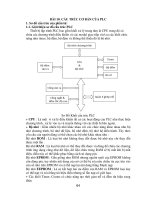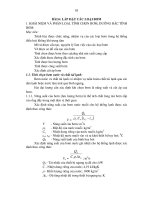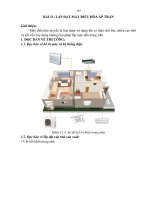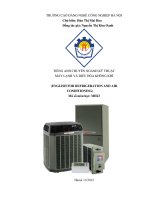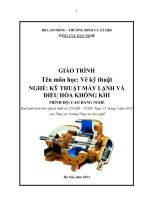giáo trình tiếng anh kỹ thuật máy lạnh và điều hòa
Bạn đang xem bản rút gọn của tài liệu. Xem và tải ngay bản đầy đủ của tài liệu tại đây (1.59 MB, 100 trang )
TRƯỜNG CAO ĐẲNG NGHỀ CÔNG NGHIỆP HÀ NỘI
Chủ biên: Hứa Thị Mai Hoa
Đồng tác giả: Nguyễn Thị Kim Oanh
TIẾNG ANH CHUYÊN NGÀNH KỸ THUẬT
MÁY LẠNH VÀ ĐIỀU HÒA KHÔNG KHÍ
(ENGLISH FOR REFRIGERATION AND AIR
CONDITIONING)
Mã số môn học: MH23
Hanoi 11/2012
TRƯỜNG CAO ĐẲNG NGHỀ CÔNG NGHIỆP HÀ NỘI
Chủ biên: Hứa Thị Mai Hoa
Đồng tác giả: Nguyễn Thị Kim Oanh
TIẾNG ANH CHUYÊN NGÀNH KỸ THUẬT
MÁY LẠNH VÀ ĐIỀU HÒA KHÔNG KHÍ
(ENGLISH FOR REFRIGERATION AND AIR
CONDITIONING)
Mã số môn học: MH23
Hanoi 11/2012
LỜI NÓI ĐẦU
Giáo trình “ TIẾNG ANH CHUYÊN NGÀNH KỸ THUẬT MÁY
LẠNH VÀ ĐIỀU HÒA KHÔNG KHÍ” được biên soạn theo chương trình đào
tạo nghề kỹ thuật máy lạnh và điều hòa không khí của tổng cục nghề, giảng
dạy cho sinh viên hệ Cao đẳng nghề của trường Cao đẳng Nghề Công nghiệp
Hà nội.
Để đáp ứng yêu cầu trên các bài trong giáo trình vừa tuân theo chương
trình vừa có những chủ đề gần gũi với sinh viên ngành kỹ thuật máy lạnh và
điều hòa không khí. Khi các em học đến phần tiếng Anh chuyên ngành thì các
em cũng đã có những kiến thức nhất định về nghề cũng như có một số kiến
thức tiếng Anh cơ bản, do đó mục tiêu của giáo trình là:
- Phát triển những kỹ năng như: đọc hiểu, dịch các tài liệu tiếng Anh
chuyên ngành kỹ thuật máy lạnh và điều hòa không khí;
- Phát triển các kỹ năng theo một hệ thống các chủ điểm gắn liền với
các hoạt động chuyên ngành kỹ thuật máy lạnh và điều hòa không khí, đặc
biệt phát triển kỹ năng đọc, dịch hiểu;
- Xây dựng và rèn luyện các kỹ năng học tập ngoại ngữ đồng thời hình
thành và phát triển khả năng độc lập suy nghĩ và sáng tạo trong giao tiếp bằng
tiếng Anh cho sinh viên;
- Đây là giáo trình mang tính chuyên ngành nên tranh ảnh nhiều, chúng
tôi đề nghị giáo trình được in mầu để sinh viên dễ dàng hơn trong việc hiểu
các khái niệm chuyên ngành bằng tiếng Anh.
Để hoàn thành việc biên soạn giáo trình, chúng tôi luôn được sự giúp
đỡ của các giáo viên trong trường. Chúng tôi xin chân thành cám ơn các giáo
viên tổ môn Tiếng Anh và Điện lạnh của nhà trường đã nhiệt tình giúp đỡ
chúng tôi trong quá trình biên soạn.
Chắc chắn giáo trình không tránh khỏi thiếu sót. Chúng tôi mong nhận
được ý kiến đóng góp để giáo trình được chỉnh sửa và hoàn thiện hơn.
Xin trân trọng cám ơn
Hà Nội,ngày 25 tháng 11 năm 2012
Tham gia biên soạn giáo trình
1. Hứa Thị Mai Hoa - Chủ biên
2. Nguyễn Thị Kim Oanh
2
Tuyên bố bản quyền
Tài liệu này là loại giáo trình nội bộ dùng trong nhà trường với
mục đích làm tài liệu giảng dạy cho giáo viên và học sinh, sinh viên
nên các nguồn thông tin có thể được tham khảo.
Tài liệu phải do trường Cao đẳng nghề Công nghiệp Hà Nội in
ấn và phát hành.
Việc sử dụng tài liệu này với mục đích thương mại hoặc khác
với mục đích trên đều bị nghiêm cấm và bị coi là vi phạm bản quyền.
Trường Cao đẳng nghề Công nghiệp Hà Nội xin chân thành cảm
ơn các thông tin giúp cho nhà trường bảo vệ bản quyền của mình.
Địa chỉ liên hệ:
Trường Cao đẳng nghề Công nghiệp Hà Nội.
131 – Thái Thịnh – Đống Đa – Hà Nội
Điện thoại:
(84-4) 38532033
Fax:
(84-4) 38533523
Website: www.hnivc.edu.vn
CONTENT
Page
Unit 1 . Fundamentals
9
Unit 2. Compressors
19
Unit 3. Installation and construction
30
Unit 4. Commitioning and maintance
42
Unit 5. Air- conditioning
54
Unit 6. Heat pump and heat recovery
66
Unit 7. Careers and job aids
76
Phụ lục
89
Tài liệu tham khảo
91
4
TỪ VIẾT TẮT DÙNG TRONG GIÁO TRÌNH
Tên đầy đủ
Viết tắt
Air Conditioner
AC
British thermal unit Recovery
Btu
Heat Recovery Ventilation
HRV
Heating, Ventilation and Air Conditioning
HVAC
Mechanical Ventilation Heat
MVHR
5
Mã môn học:
Thời gian:
CHƯƠNG TRÌNH MÔN HỌC
MH 23
45 giờ
(Lý thuyết: 21giờ; Thực hành: 24 giờ)
I. VỊ TRÍ, TÍNH CHẤT MÔN HỌC
- Vị trí:
+ Môn tiếng Anh chuyên ngành là môn học áp dụng trong các khối đào
tạo về kỹ thuật cụ thể và thường được thường được bố trí thực hiện sau khi
học sinh đã học xong phần tiếng Anh không chuyên 1, 2;
+ Môn học tiếng Anh chuyên ngành trang bị cho sinh viên các kĩ năng
thực hành tiếng cơ bản để có thể sử dụng tiếng Anh trong ngữ cảnh chuyên
ngành ở mức độ cơ sở, củng cố và cung cấp cho sinh viên những kiến thức cơ
bản về chuyên ngành kỹ thuật máy lạnh và điều hòa không khí, giúp cho
người học có thể liên kết những ngôn ngữ đã được học với kinh nghiệm thực
tế trong công việc liên quan đến ngành kỹ thuật máy lạnh và điều hòa không
khí của mình.
- Tính chất:
+ Là môn học bắt buộc.
II. MỤC TIÊU CỦA MÔN HỌC
- Củng cố kiến thức và kỹ năng mà sinh viên đã được học ở học phần
tiếng Anh không chuyên 1, 2
- Cung cấp và mở rộng các cấu trúc ngữ pháp và từ vựng chuyên ngành
kỹ thuật máy lạnh và điều hòa không khí thông dụng, chú ý tới các yếu tố liên
kết văn bản tiếng Anh
- Cung cấp từ vựng về chuyên ngành kỹ thuật máy lạnh và điều hòa
không khí (300 thuật ngữ)
- Phát triển các kỹ năng theo một hệ thống các chủ điểm gắn liền với
các hoạt động chuyên ngành về Kỹ thuật máy lạnh và điều hòa không khí, đặc
biệt phát triển kỹ năng đọc, dịch hiểu
- Xây dựng và rèn luyện các kỹ năng học tập ngoại ngữ đồng thời hình
thành và phát triển khả năng độc lập suy nghĩ và sáng tạo trong giao tiếp bằng
tiếng Anh cho sinh viên
6
- Phát triển kỹ năng làm việc theo cặp, theo nhóm
- Định hướng cho sinh viên tầm quan trọng của tiếng Anh trong cuộc
sống và trong công việc tưong lai
- Rèn luyện tính cẩn thận, chính xác trong quá trình làm việc
- Rèn luyện tính khoa học, tính sáng tạo trong giao tiếp.Nội dung của
môn học
III. NỘI DUNG MÔN HỌC
1. Nội dung tổng quát và phân phối thời gian
Thời gian
Số
TT
Tên chương, mục
Tổng
số
Thực
Lý
hành
thuyết Bài
tập
I
Unit 1: Fundamentals
6
3
3
II
Unit 2: Compressors
6
3
3
III
Unit 3: Installation and construction
6
3
3
IV
Progress test 1
1
V
Unit 4: Commissioning and
maintance
6
3
3
VI
Unit 5: Air-conditioning
6
3
3
VII
Unit 6: Heat pumps and heat recovery
6
3
3
VIII Unit 7: Careers and job aids
6
3
3
IX
Progress test 2
1
X
Revision
1
Cộng
45
Kiểm
tra*
(LT
hoặc
TH)
1
1
1
21
22
2
* Ghi chú: Thời gian kiểm tra lý thuyết được tính vào giờ lý thuyết,
kiểm tra thực hành được tính bằng giờ thực hành.
2. Yêu cầu về đánh giá hoàn thành môn học
2.1. Về kiến thức
- Được đánh giá qua bài viết, kiểm tra vấn đáp hoặc trắc nghiệm, tự
luận, thực hành đạt các yêu cầu
- Nói và viết về kỹ thuật máy lạnh và điều hòa không khí trong cuộc
sống hàng ngày.
- Sử dụng các từ viết tắt khi nói về kỹ thuật máy lạnh và điều hòa
không khí.
- Xây dựng các từ mới bằng cách sử dụng tiếp đầu ngữ, đuôi từ và ghép
từ
2.2. Về kỹ năng
Đánh giá kỹ năng thực hành của người học trong bài thực hành Anh
văn đạt được các yêu cầu sau:
- Phân biệt các thiết bị thuộc về kỹ thuật máy lạnh và điều hòa không
khí
- Nói về các thiết bị thuộc về kỹ thuật máy lạnh và điều hòa không khí
và ứng dụng của nó.
- Đọc hiểu được một số tài liệu chuyên ngành kỹ thuật máy lạnh và
điều hòa không khí.
2.3. Về thái độ
- Cẩn thận, tự giác, chính xác.
UNIT 1
FUNDAMENTALS OF REFRIGERATION
I. READING COMPREHENSION
Fundamentals of refrigeration
REFRIGERATION is the process of removing heat from an area or a
substance and is usually done by an artificial means of lowering the
temperature, such as the use of ice or mechanical refrigeration.
Nature of Heat
Heat is a form of energy contained to some extent in every substance
on earth. All known elements are made up of very small particles, known as
atoms, which, when joined together, form molecules. These molecules are
particular to the form they represent. For example, carbon and hydrogen in
certain combinations form sugar and in others form alcohol.
9
When heat is added to a substance, the rate of molecular motion
increases, causing the substance to change from a solid to a liquid, and then to
a gas (vapor). For example, in a cube of ice, molecular motion is slow, but as
heat is added, molecular activity increases, changing the solid "ice" to a liquid
"water" (Fig. 6-1).
Units of Heat
The amount of heat added to, or subtracted from, a body can best be
measured by the rise or fall in temperature of a known weight of a substance.
The standard unit of heat measure is the amount of heat necessary to raise the
temperature of 1 pound of water 1°F at sea level when the water temperature
is between 32°F and 212°F. Conversely, it is also the amount of heat that
must be extracted to lower by 1oF the temperature of a pound of water
between the same temperature limits. This unit of heat is called a British
thermal unit (Btu). The Btu's equivalent in the metric system is the calorie,
which is the amount of heat required to raise one gram of water 1 o Celsius.
UNDERSTANDING THE PASSAGE
Task 1. Answer the following questions
1. What is refrigeration?
…………………………………………………………………………………
…………………………………………………………………………………
2. What is heat?
…………………………………………………………………………………
…………………………………………………………………………………
3. What happens when heat is added to a substance?
…………………………………………………………………………………
…………………………………………………………………………………
4. Why does the substance change from a solid to a liquid?
…………………………………………………………………………………
…………………………………………………………………………………
5. What is the unit of heat called?
…………………………………………………………………………………
…………………………………………………………………………………
Task 2. Are these sentences true or false? Correct the false sentences.
1. Refrigeration is the process of adding heat from an area or a substance.
…………………………………………………………………………………
….………………………………………………………………………………
2. Carbon and hydrogen in certain combinations form sugar and in others
form alcohol.
…………………………………………………………………………………
….………………………………………………………………………………
3. When heat is remove from a substance, the rate of molecular motion
increases.
…………………………………………………………………………………
….………………………………………………………………………………
4. The standard unit of heat measure is the amount of heat necessary to raise
the temperature.
…………………………………………………………………………………
….………………………………………………………………………………
5. The calorie is the amount of heat required to fall one gram of water 1 o
Celsius.
…………………………………………………………………………………
….………………………………………………………………………………
Task 3. Choose the best answer
1. Refrigeration is usually done by an artificial means of ……..the
temperature.
A. adding B. lowering
C. removing
D. causing
2. All known elements are ………….up of very small particles
A. adding B. done
C. certain
D. made
3. Carbon and hydrogen in certain combinations …………sugar.
A. form
B. metric
C. measured
D. causing
4. A body can best be …………by the rise or fall in temperature .
A. adding B. lowering
C. measured
D. metric
5. The Btu's equivalent in the …………..system is the calorie.
A. rise
B. metric C. removing
D. certain
II. LANGUAGE WORK
THE PRESENT SYMPLE
FORM
[VERB] + s/es in third person
Use the Simple Present to express the idea that an action is repeated or
usual. The action can be a habit, a hobby, a daily event, a scheduled event or
something that often happens. It can also be something a person often forgets
or usually does not do.
Examples:
- Heat is a form of energy contained to some extent in every substance
on earth.
- REFRIGERATION is the process of removing heat from an area or
a substance
ACTIVE / PASSIVE
Examples:
- Molecules are in a constant state of motion.
- All known elements are made up of very small particles
ACTIVE
PASSIVE
III. PRACTICE
Exercise 1. Rearrange these words to make the sentences
1. is /Refrigeration / the /of /heat./ process/ removing
…………………………………………………………………………………
…..……………………………………………………………………………
2. is /Heat/ a / energy. / form/ of
…………………………………………………………………………………
…..……………………………………………………………………………
3. molecular / rate / The /of / increases./ motion
…………………………………………………………………………………
…..……………………………………………………………………………
4. best / body/ A/ can /be /by / measured /the /in /rise/ fall /temperature ./ or
…………………………………………………………………………………
…..……………………………………………………………………………
5. unit /heat /This /of /is /a /thermal /called / unit./ British
…………………………………………………………………………………
…..……………………………………………………………………………
Exercise 2. Match the words in A to the appropriate phrase in B
A
B
1. refrigeration
a. a form of energy expands and fills whatever space
2. Btu
b. the amount of heat necessary to raise the
temperature
3. Heat
c. British thermal unit
4. substances
d. the process of removing heat from an area or a
substance
5. The standard unit of
e. solid, liquid, and gas
heat measure
Exercise 3. Put a word to complete the passage
a glass tube ;
scales ;
a thermometer; the controls ;
these liquids
Measurement of Heat
The usual means of measuring temperature is …………. It measures
the degree or intensity of heat and usually consists of ………. with a bulb at
the lower portion of the tube that contains mercury, colored alcohol, or a
volatile liquid. The nature of ……….. causes them to rise or fall uniformly in
the hollow tube with each degree in temperature change. Thermometers are
used to calibrate ………. of refrigeration. The two most common
thermometer …………are the Fahrenheit and the Celsius.
Exercise 4. Translate the sentences into Vietnamese
1. Refrigeration is the process of removing heat from an area or a substance
and is usually done by an artificial means of lowering the temperature, such as
the use of ice or mechanical refrigeration.
…………………………………………………………………………………
…..……………………………………………………………………………
………..………………………………………………………………………
……………..…………………………………………………………………
…………………..……………………………………………………………
………………………..………………………………………………………
2. Heat is a form of energy contained to some extent in every substance on
earth. All known elements are made up of very small particles, known as
atoms, which, when joined together, form molecules.
…………………………………………………………………………………
…..……………………………………………………………………………
…………………………………………………………………………………
…………………………………………………………………………………
…………………………………………………………………………………
3. The standard unit of heat measure is the amount of heat necessary to raise
the temperature of 1 pound of water 1°F at sea level when the water
temperature is between 32°F and 212°F.
…………………………………………………………………………………
…..……………………………………………………………………………
…………………………………………………………………………………
…………………………………………………………………………………
…………………………………………………………………………………
Exercise 5. Translate the sentences into English
1. Nhiệt không thể bị phá hủy hay biến mất. Tuy nhiên, nó có thể truyền từ
người này hay chất này sang người khác hay chất khác hay sang một dạng
năng lượng khác.
…………………………………………………………………………………
…..……………………………………………………………………………
…………………………………………………………………………………
…………………………………………………………………………………
…………………………………………………………………………………
…………………………………………………………………………………
…………………..……………………………………………………………
2. Khi nhiệt được thêm vào một chất, mức độ chuyển động của các phân tử
tăng lên, làm cho các chất bị chuyển đổi từ chất rắn sang chất lỏng, và sau đó
là chất khí.
…………………………………………………………………………………
…………………………………………………………………………………
…………………………………………………………………………………
…………………………………………………………………………………
…………………………………………………………………………………
……………..…………………………………………………………………
3. Vì bản thân nhiệt không phải là chất; tốt nhất nó nên được xem xét với
những ảnh hưởng của nó trên các chất hay với cơ thể con người.
………………………………………………………………………………….
…………………………………………………………………………………
…………………………………………………………………………………
…………………………………………………………………………………
Exercise 6. Think about Refrigeration then answer the questions
1. What do you think is the most important refrigeration machine in your life?
…………………………………………………………………………………
…..……………………………………………………………………………..
2. Which refrigeration machines do you think make our lives easier?
…………………………………………………………………………………
…..……………………………………………………………………………..
3. Which refrigeration machines do you think make our lives more difficult?
…………………………………………………………………………………
…..……………………………………………………………………………..
4. Would refrigeration machines be for everyone or only the very rich?
…………………………………………………………………………………
…..……………………………………………………………………………..
5. What refrigeration machines do you use everyday in your life?
…………………………………………………………………………………
…..……………………………………………………………………………..
IV. FURTHER READING
Transfer of Heat
Heat flows from a substance of higher temperature to bodies of lower
temperature in the same manner that water flows down a hill, and like water,
it can be raised again to a higher level so that it may repeat its cycle.
When two substances of different temperatures are brought in contact
with each other, the heat will immediately flow from the warmer substance to
the colder substance. The greater the difference in temperature between the
two substances, the faster the heat flow. As the temperature of the substances
tends to equalize, the flow of heat slows and stops completely when the
temperatures are equalized. This characteristic is used in refrigeration. The
heat of the air, of the lining of the refrigerator, and of the food to be preserved
is transferred to a colder substance, called the refrigerant.
Three methods by which heat may be transferred from a warmer
substance to a colder substance are conduction, convection, and radiation.
V. VOCABULARY
- artificial:
- apparatus:
- atoms:
- absorb:
- application:
- British thermal unit (Btu):
- Calorie:
- combination:
- construct:
- constant:
- Conversely:
- concentrate:
- deal:
- destroy:
- definite:
- effect:
- extent:
- element:
- entirely:
- extract:
- equals:
- Fundamentals:
- form:
- gallon:
- indicate:
- intensity:
- jar:
- liquid:
- motion:
Nhân tạo
dụng cụ, thiết bị
Nguyên tử
hút thu (nước); Hấp thu
sự áp dụng, ứng dụng
đơn vị nhiệt của Anh (bằng 0,252 Kcal)
ca-lo (đơn vị đo nhiệt lượng)
hỗn hợp; kết hợp
cấu tạo; đặt; dựng
giữ nguyên; hằng
ngược lại; đảo lại
cô đặc; tập trung
dàn xếp; giải quyết
Phá, phá hoại, phá huỷ
Xác đinh, định rõ
ảnh hưởng, hiệu quả
Quy mô, phạm vi
yếu tố phân tử
Toàn vẹn, hoàn toàn
rút; sự tách; tách ra
lượng bằng nhau; lượng cân bằng
nguyên tắc, cơ bản
Hình thức dạng, mẫu
Galông 4,54 lít Anh, 3,78 lít Mỹ)
chỉ báo; chỉ dẫn
Độ mạnh, cường độ
Vại, lọ, bìnhl (điện học) chai
Chất lỏng, chất nước
Sự chuyển động
- molecule:
- nature:
- particle:
- pound:
- quart:
- quantity:
- raise:
- represent:
- refrigeration:
- solid :
- substance:
- steam:
- subtract:
- separation:
- transfer:
- uniform:
- vapor:
- volume:
- weight:
phân tử
tự nhiên; bản chất
chất điểm; hạt; phần tử
pao (0,4536kg.); đồng bảng Anh
qt lít Anh (1,14 lít); 1/4 galông
số lượng, khối lượng
Nâng lên, đưa lên
Trình bày; đại diện cho
sự làm lạnh
chất rắn
Chất liệu; vật chất
Hơi nước
(toán học) trừ
Sự chia cắt, ngăn cách
Dời, chuyển, dọn
đồng dạng, một kiểu
Hơi, (v) hóa hơi, bốc hơi
Thể tích, âm lượng
wt trọng lượng
UNIT 2
COMPONENTS: THE COMPRESSORS
I. READING COMPREHENSION
Refrigeration compressors have but one purpose—to withdraw the
heat-laden refrigerant vapor from the evaporator and compress the gas to a
pressure that will liquefy in the condenser. The designs of compressors vary,
depending upon the application and type of refrigerant. There are three types
of compressors classified according to the principle of operation—
reciprocating, rotary, and centrifugal.
External Drive Compressor. — An external drive or open-type
compressor is bolted together. Its crankshaft extends through the crankcase
and is driven by a flywheel (pulley) and belt, or it can be driven directly by an
electric motor.
Hermetic Compressor—In the hermetically sealed compressor, the
electric motor and compressor are both in the same airtight (hermetic)
housing and share the same shaft. Note that after assembly, the two halves of
the case are welded together to form an airtight cover. The compressor, in this
20
case, is a double-piston reciprocating type. Other compressors may be of the
centrifugal or rotary types.
UNDERSTANDING THE PASSAGE
Task 1. Answer the following questions
1. What are refrigeration compressors purpose?
…………………………………………………………………………………
…………………………………………………………………………………
2. How many types of compressors are there?
…………………………………………………………………………………
…………………………………………………………………………………
3. Are these devices too complicated to explain here?
…………………………………………………………………………………
…………………………………………………………………………………
4. What do we note after assembly?
…………………………………………………………………………………
…………………………………………………………………………………
5. What is a double-piston reciprocating type?
…………………………………………………………………………………
…………………………………………………………………………………
Task 2. Are these sentences true or false. Correct the false sentences
1. Compressors will be explained further here except to discuss the special
methods used seal mompressors to prevent escape of refrigerant.
…………………………………………………………………………………
…………………………………………………………………………………
2. Before repairing any compressor, don’t check the manufacture’s manual for
an explaination.
…………………………………………………………………………………
…………………………………………………………………………………
3.Two types of seals are used the staionary bellows seal and the rotating
bellows seal.
…………………………………………………………………………………
…………………………………………………………………………………
4. The two halves of the case are welded different from form an airtight cover.
…………………………………………………………………………………
…………………………………………………………………………………
5.Other refrigeration may be of the centrifugal or rotary types.
…………………………………………………………………………………
…………………………………………………………………………………

